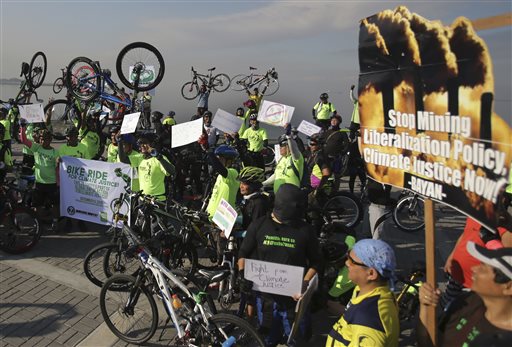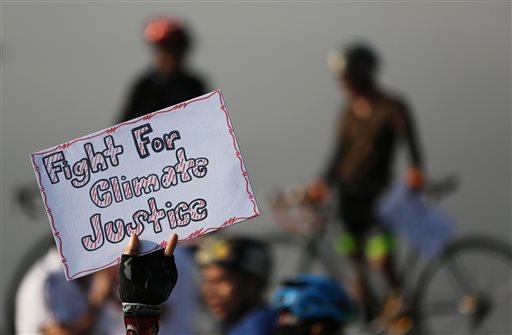Key points of historic Paris Agreement

Filipinos raise their bicycles as they join a rally in Manila, Philippines on Sunday, Dec. 13, 2015 to criticize the agreement reached during the United Nations conference on climate change, Conference of Parties 21 (COP21) in Paris. Nearly 200 nations adopted the first global pact to fight climate change on Saturday, calling on the world to collectively cut and then eliminate greenhouse gas pollution but imposing no sanctions on countries that don’t. AP PHOTO/Aaron Favila
THE Paris Agreement that was concluded over the weekend to cheers, relief and tears made history for bringing together 195 nations big and small, poor and rich, for the first time to fight global warming.
The 31-page text of the pact, which will come into effect in 2020, essentially makes mitigation efforts voluntary rather than binding.
Here’s a look at its key points, plus comments from analysts and observers:
- The 2 degrees C target
The world will strive to limit global warming to “well below” 2 degrees Celsius compared to pre-Industrial Revolution levels, and aim for 1.5 deg C if possible. Developed countries should take “the lead” by taking on absolute emissions cuts while developing nations are encouraged to enhance their efforts. One key step through which this target will be achieved is to limit the amount of greenhouse gases emitted by human activity to the level that trees, soil and oceans can absorb, beginning at some point between 2050 and 2100.
“Politically as well as technologically, this is no walk in the park,” said Ottmar Edenhofer, chief economist at the Potsdam Institute for Climate Impact Research Institute near Berlin, and a lead author of the UN’s most rigorous assessment of climate economics, according to Bloomberg. The target may trigger “a fundamental shift of investments towards renewables, energy efficiency, and carbon capture and storage,” he said.
Article continues after this advertisement- Funding for developing countries
Industrialized countries promised in 2009 to provide US$100 billion (S$141.36 billion) per year to help poor countries adapt to the impacts of climate change by 2020. In Paris, they could only agree to use the US$100 billion figure as a “floor” for subsequent years. The figure must be updated by 2025.
Article continues after this advertisement- Monitoring
Governments agreed to set up a framework for monitoring, measuring and verifying emissions reductions. This will promote transparency and put pressure on underperformers. Developing countries were given some flexibility on the scope, frequency and level of detail of reporting. Small island states and the least developed countries have lower requirements.
“The heart of the deal is emissions monitoring. The only way we’re going to be able to compel compliance is through accurate data,” said Paul Bledsoe, a climate aide during US President Bill Clinton’s administration, told Bloomberg.
- Reviews
The Inter-governmental Panel on Climate Change (IPCC), the UN climate science and research body, is tasked to issue a report in 2018 detailing steps needed to reach the 2- and 1.5-deg-C targets. The deal also requests that countries re-submit their current pollution-reduction pledges by 2020, and do so every five years. That is because current targets plans would limit warming to only between 2.7 and 3.5 deg C.
“In other words, we will analyses how far we are in reaching the 2 deg C goal; then will have an update of our policy plans,” Jos Delbeke, director general for climate at the European Commission, the EU’s executive arm was quoted as saying by Bloomberg. “If we have that cycle repeated every five years we’re going to reach the target.”
RELATED VIDEOS
